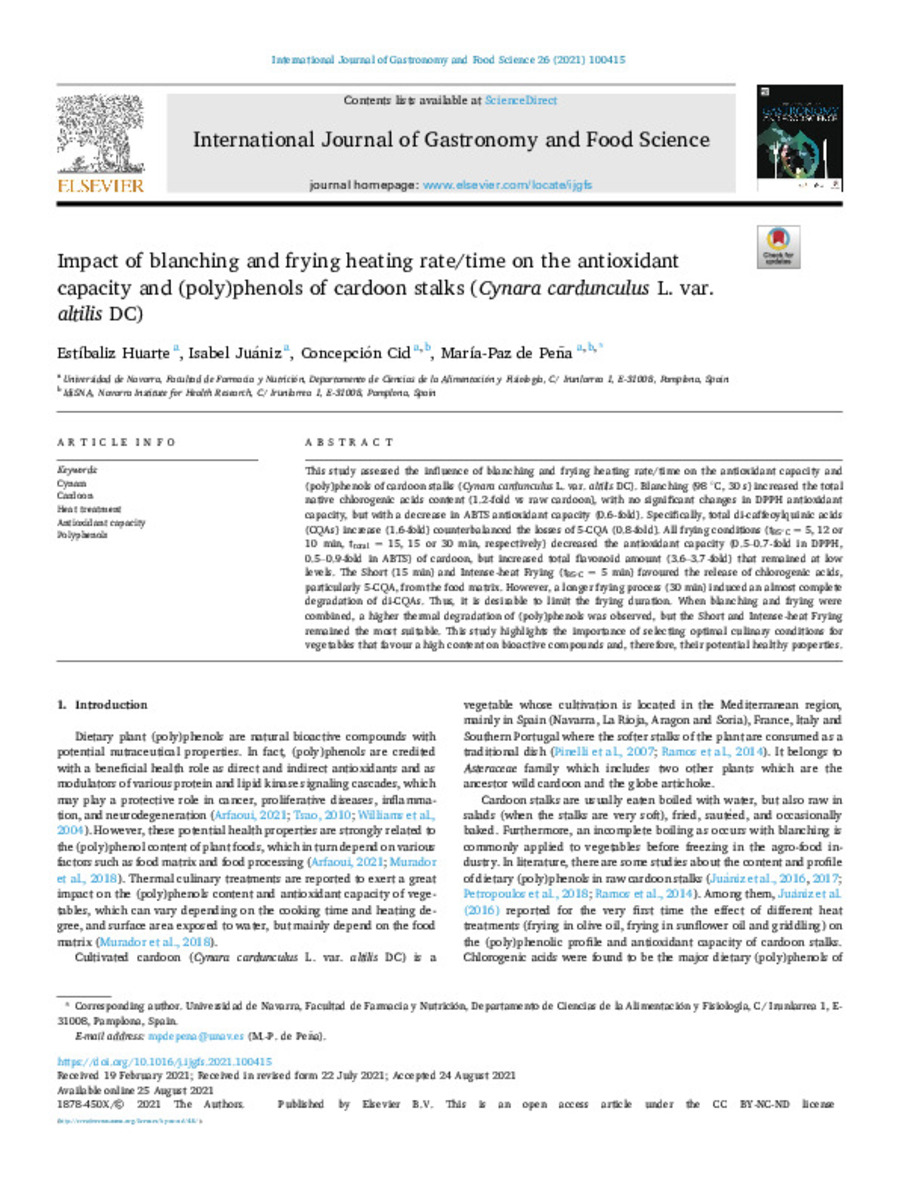Full metadata record
| DC Field | Value | Language |
|---|---|---|
| dc.creator | Huarte, E. (Estibaliz) | - |
| dc.creator | Juaniz, I. (Isabel) | - |
| dc.creator | Cid, C. (Concepción) | - |
| dc.creator | De-Peña, M.P. (María Paz) | - |
| dc.date.accessioned | 2022-04-06T14:25:05Z | - |
| dc.date.available | 2022-04-06T14:25:05Z | - |
| dc.date.issued | 2021 | - |
| dc.identifier.citation | Huarte, E. (Estibaliz); Juaniz, I. (Isabel); Cid, C. (Concepción); et al. "Impact of blanching and frying heating rate/time on the antioxidant capacity and (poly)phenols of cardoon stalks (cynara cardunculus L. var. altilis DC)". International Journal of Gastronomy and Food Science. 26 (100415), 2021, | es_ES |
| dc.identifier.issn | 1878-450X | - |
| dc.identifier.uri | https://hdl.handle.net/10171/63367 | - |
| dc.description.abstract | This study assessed the influence of blanching and frying heating rate/time on the antioxidant capacity and (poly)phenols of cardoon stalks (Cynara cardunculus L. var. altilis DC). Blanching (98 °C, 30 s) increased the total native chlorogenic acids content (1.2-fold vs raw cardoon), with no significant changes in DPPH antioxidant capacity, but with a decrease in ABTS antioxidant capacity (0.6-fold). Specifically, total di-caffeoylquinic acids (CQAs) increase (1.6-fold) counterbalanced the losses of 5-CQA (0.8-fold). All frying conditions (t85°C = 5, 12 or 10 min, ttotal = 15, 15 or 30 min, respectively) decreased the antioxidant capacity (0.5–0.7-fold in DPPH, 0.5–0.9-fold in ABTS) of cardoon, but increased total flavonoid amount (3.6–3.7-fold) that remained at low levels. The Short (15 min) and Intense-heat Frying (t85°C = 5 min) favoured the release of chlorogenic acids, particularly 5-CQA, from the food matrix. However, a longer frying process (30 min) induced an almost complete degradation of di-CQAs. Thus, it is desirable to limit the frying duration. When blanching and frying were combined, a higher thermal degradation of (poly)phenols was observed, but the Short and Intense-heat Frying remained the most suitable. This study highlights the importance of selecting optimal culinary conditions for vegetables that favour a high content on bioactive compounds and, therefore, their potential healthy properties. | es_ES |
| dc.description.sponsorship | This research was supported by the Spanish Ministry of Science and Innovation (AGL2014-52636-P). E. Huarte thanks to Asociación de Amigos de la Universidad de Navarra (Spain) and Banco Santander (Spain) for the PhD grants received. I. Juániz expresses her gratitude to Asociación de Amigos de la Universidad de Navarra (Spain) for the PhD grant received. | es_ES |
| dc.language.iso | eng | es_ES |
| dc.publisher | Elsevier | es_ES |
| dc.rights | info:eu-repo/semantics/openAccess | es_ES |
| dc.subject | Cynara | es_ES |
| dc.subject | Cardoon | es_ES |
| dc.subject | Heat treatment | es_ES |
| dc.subject | Antioxidant capacity | es_ES |
| dc.subject | Polyphenols | es_ES |
| dc.title | Impact of blanching and frying heating rate/time on the antioxidant capacity and (poly)phenols of cardoon stalks (cynara cardunculus L. var. altilis DC) | es_ES |
| dc.type | info:eu-repo/semantics/article | es_ES |
| dc.description.note | This is an open access article under the CC BY-NC-ND license | es_ES |
| dc.identifier.doi | 10.1016/j.ijgfs.2021.100415 | - |
| dadun.citation.number | 26 | es_ES |
| dadun.citation.publicationName | International Journal of Gastronomy and Food Science | es_ES |
| dadun.citation.startingPage | 100415 | es_ES |
Files in This Item:
Statistics and impact
Items in Dadun are protected by copyright, with all rights reserved, unless otherwise indicated.






